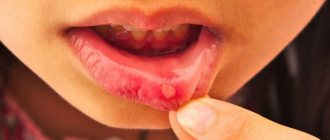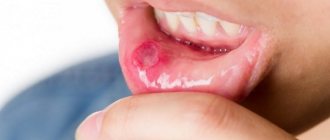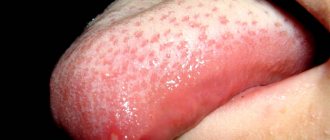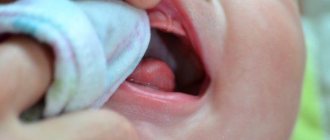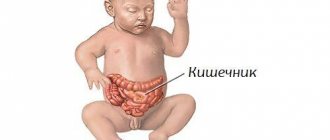Causes of stomatitis
In children, as in adults, stomatitis can be caused by viruses, fungi, bacteria, allergies and injuries. About six months after birth, the child loses the immunity received from the mother, the protective power of the immune system changes, and the child’s body becomes more susceptible to infections. The oral mucosa in children is more delicate and easier to injure; children also more often “bite” their cheeks after dental treatment due to a temporary loss of sensitivity after anesthesia, which causes traumatic stomatitis.
Children are not always motivated to brush their teeth, so poor hygiene can also cause stomatitis.
With the following diseases, stomatitis is observed in children much more often: chronic tonsillitis, diabetes mellitus, heart defects, chronic hepatitis.
Treatment
If you detect at least one of the symptoms, you should immediately consult a doctor. Timely detection of the disease allows you to prescribe effective treatment. It is compiled individually, taking into account all the characteristics of the patient. In some cases, tests are required to identify pathogenic microorganisms. Local and general therapy is usually used.
Aphthous stomatitis is not contagious, but in order not to expose the child to additional infections, it is recommended to limit walks in the fresh air during treatment.
Depending on the diagnosis, the following may be prescribed:
- Antipyretics.
- Vitamin course.
- Painkiller.
- Anti-inflammatory.
The initial goal is to eliminate pain and alleviate the condition. For this purpose, antiseptic treatment of the oral cavity is carried out. It prevents the addition of secondary infections. In addition to medications, rinses from decoctions are used:
- Sage.
- Motherwort.
- St. John's wort.
- Daisies.
- Calendula.
- Oak bark.
They cannot replace medical treatment, but these herbs will not hurt as an aid. Before you start rinsing your mouth with herbs, you need to make sure you are not allergic to them.
Treatment of aphthous stomatitis in children is not complete without procedures aimed at strengthening general and local immunity. It is recommended to adhere to proper nutrition and take vitamins. Electrophoresis sessions are possible. Sour fruits, juices, tea, hard, spicy and very salty foods, and carbonated drinks are excluded from the diet. This is necessary in order not to injure areas of inflammation.
If the cause of the disease is dental problems, then dental treatment is prescribed. By treating your teeth, you will be able to quickly get rid of aphthous stomatitis, since the cause of its development will be eliminated.
In infants, aphthous stomatitis is often a reaction to mother's milk. If intolerance is confirmed, the baby must be switched to formula milk.
Classification of HRAS (chronic recurrent aphthous stomatitis)
| CLASSIFICATION | A COMMENT | ||
| classification: | According to the degree of damage to the mucous membrane: | a comment: | 1) Superficial (catarrhal, fibrinous) 2) Deep (ulcerative, necrotic) |
| classification: | According to the clinical course: | a comment: | 1) acute 2) chronic |
All types of stomatitis occur in children, but the most common are: herpetic, candidal and traumatic stomatitis.
Acute herpetic stomatitis
It occurs most often, and mainly affects children from 10 months to 3 years.3 The appearance of rashes is preceded by inflammation of the lymph nodes.
With a mild form
In acute herpetic stomatitis, the temperature rises to 37-37.5°C, the general condition is satisfactory, slight swelling and redness may occur on the gums, then up to six blisters appear, which burst with the formation of painful aphthae surrounded by a red rim.
Afta is a round-shaped erosion. Aphthae may merge together. The rash appears once, and after 1-2 days the erosion gradually heals.
Moderate form
Acute herpetic stomatitis is characterized by deterioration of the child’s well-being, weakness, and headache. The child is capricious, has no appetite, the lymph nodes are enlarged and painful, the temperature rises to 38-39°C, the symptoms resemble ARVI. The oral mucosa is swollen, reddened, rashes appear (bubbles, then erosions) of 10-15 pieces, and often there are rashes on the face. Salivation increases, and gingivitis appears (inflammation of the gums, accompanied by bleeding). The rash may appear several times, i.e. after the old ones heal, new ones appear. Healing of erosions takes up to 4-5 days. Bleeding gums and swollen lymph nodes persist for some time after the erosions have healed.
Severe form
It begins as an acute respiratory viral infection, there is pain in the muscles, joints, tachycardia and bradycardia (increased and slow heartbeat), and nosebleeds may even be observed. In this form, the temperature is high up to 40°C, gingivitis is pronounced, the mucous membrane is bright red, swollen, the child’s lips are dry, the mucous membrane of the eyes is swollen, reddened. The rashes constantly appear again, their number can reach 100. Rashes often appear around the mouth, on the eyelids, on the mucous membranes of the eyes, between the fingers, on the earlobes. Simple gingivitis turns into ulcerative (a more severe form of gum inflammation, with the formation of ulcers), salivation increases, and bad breath appears. Recovery is long and hospitalization is often required.
What do doctors advise for home care?
The specialist makes a diagnosis and prescribes treatment, and the implementation of all instructions falls entirely on the shoulders of the parents. Caring for a small child with stomatitis contains many nuances. For example, during this period you should feed your baby only warm food with a mushy consistency, excluding citrus, sour and spicy foods. After eating, be sure to rinse your mouth. If the baby is still very small, then after eating you should give him a little boiled water to drink. Treatment of the oral cavity and application of gels prescribed by a doctor should be done with a special fabric fingertip or a finger wrapped in a bandage (the bandage should then be thrown away).
Important: self-medication is dangerous. Only a doctor can correctly diagnose and give the correct therapeutic recommendations.
Enteroviral vesicular stomatitis (arm - leg - mouth)
Caused by enteroviruses. It also occurs in adults, but in 95.7% of cases children are affected.6 It is characterized by seasonal occurrence (summer - autumn) and group incidence.4 It is observed mainly in children under 10 years of age. Vesicular stomatitis is contagious, so it is recommended to use separate utensils and hygiene products. Characteristics for this disease: temperature 37.5-38, weakness, headache, muscle pain, rash on the palms, soles, as well as blisters on the hard palate and pharynx, which then turn into erosions that are almost not painful.
Types of stomatitis and causes of occurrence in children
The causes of stomatitis in children can be different, and they are directly related to the type of disease. In this section, we will look at the main types of stomatitis and their causes in children.
Herpetic viral stomatitis
This type of stomatitis is the most common and common. Sometimes this type of disease is simply called herpetic stomatitis or viral . Typically occurs in children aged 1 to 4 years.
Often infection occurs through airborne droplets. Infection with herpetic viral stomatitis is also possible through children's toys, dishes and other objects. Against the background of weak immunity, the virus enters the body and settles in the most damaged areas of the mucous membrane. Such places can serve, for example, as small wounds that appear after a child bites his lips.
Aphthous (allergic) stomatitis
This type of stomatitis is often also called drug stomatitis , since the main reason for the appearance of this type of disease is allergic reactions to various medications. It is impossible to say exactly which drugs can cause stomatitis; this is an individual predisposition, and can only be accurately determined by visiting a pediatric dentist after all the necessary diagnostics have been carried out. This type of disease occurs infrequently and, most often, in preschool children.
Traumatic stomatitis
As the name implies, this type of disease occurs after mechanical trauma to the child’s oral cavity and the entry of dirt and bacteria into these places.
Injuries can be of a completely different nature. This could be purely a dental problem. For example, due to an incorrect bite, a child may constantly bite his tongue or lips. Other types of mechanical damage to the mucous membrane include burns, for example, from food that is too hot, a pacifier that is too hard, various bad habits (pulling toys into the mouth, chewing a pencil, etc.).
Candidal (fungal) stomatitis
The main cause of candidal stomatitis is Candida fungi. Basically, this type of disease is typical for children under 1 year of age who are breastfed. Particles of mother's milk remaining in the baby's mouth after feeding provide an excellent environment for the development of this type of fungus. For this reason, sometimes this type of stomatitis is called thrush .
Infectious (microbial) stomatitis
The main reason for the appearance of infectious stomatitis in children is a decrease in immunity against the background of diseases such as tonsillitis, sinusitis, pneumonia and other diseases of the nasopharynx. This type of disease occurs in children of both school and preschool age. Infectious stomatitis develops especially often in the autumn-winter period, when the child’s immunity is weakened.
Acute pseudomembranous candidal stomatitis (thrush)
Acute pseudomembranous candidal stomatitis (thrush) occurs:
- Light shape
- Medium-heavy forms
- Severe form
The main symptom of the disease is a white or yellow coating.
With a mild form
The plaque is located in islands, most often on the tongue and cheeks. Children are restless, sleep poorly, and suck the breast sluggishly. Older children may complain of a burning sensation. The plaque is easily removed; underneath there is a bright red mucous membrane. The disease lasts no longer than 7 days.5
Moderate form
The plaque is located on the cheeks, tongue, hard palate, and mucous membranes of the lips. Under the plaque, erosions form, which sometimes bleed. The plaque is more difficult to remove. Lymph nodes are sometimes enlarged and painful. The duration of the disease is 10-15 days, there are relapses.
Moderate form
The plaque is dirty gray, almost cannot be removed, and is located on the tongue, cheeks, soft palate, tonsils, pharynx, and mucous membranes of the lips. Cheilitis appears in the corners of the mouth - inflammation of the lips. The oral mucosa is dry and inflamed. The child’s health is impaired, the child refuses to eat, and the temperature rises. Lesions in the genital area, neck folds, and between the fingers are also common. The disease is long-term, with frequent relapses.
Bacterial stomatitis in children
Necrotizing ulcerative stomatitis is more common in weakened children and is caused by fusobacteria and spirochetes. May be a sign of periodontal disease (progressive destruction of periodontal tissue). It is characterized by the appearance of painful ulcers, weakness, gingivitis (inflammation of the gums), enlarged and painful lymph nodes, difficulty eating, speaking, and bad breath.
Often, erosions in traumatic stomatitis can become infected through dirty hands, toys and other objects, then bacterial stomatitis develops, so it is important to pay attention to antiseptic treatment.
Traumatic stomatitis in children
A specific form of traumatic stomatitis in children is Bednar's aphthae . This is a traumatic erosion of the oral mucosa. In children, unlike adults, the mucosal epithelium consists not of four layers, but of two, so it is easily injured. The cause may be early teething, a rough nipple from the mother, or a long nipple on the bottle. Erosion is most often located in the middle of the palate or opposite the cutting edge of the teeth. The child begins to refuse food, cries, and sleeps poorly.
Traumatic stomatitis also occurs in children when wearing braces. Erosions have uneven edges, are painful, and are usually located on the mucous membrane of the cheeks and lips, less often on the tongue.
Allergic stomatitis
Allergic damage to the mucous membrane most often occurs in the form of contact stomatitis and chronic aphthous form of the disease1.
Allergens can include medications, food products, varnishes and paints that coat toys, toothpastes, mouth rinses, chewing gum, and dental metals included in braces1,2.
With allergic stomatitis in children, erosions and ulcers may appear in the mouth, but more often the matter is limited to redness and swelling of the mucous membrane1.
Treatment is avoiding contact with the allergen, rinsing or irrigating the mouth with antiseptic solutions to prevent infection. If necessary, doctors recommend taking antihistamines1,2.
Chronic recurrent aphthous stomatitis often occurs in schoolchildren and adolescents due to allergies2. In addition, its development can be provoked by diseases of the gastrointestinal tract, upper respiratory tract infections, disorders of the nervous system, and hypovitaminosis1,2.
With aphthous stomatitis in children, itching and burning first appear in the oral cavity. The mucous membrane at the site of the lesion becomes red and swollen, then an aphtha forms on it - a round or oval erosion 0.5-1 cm in diameter rising above the surrounding tissues with a red rim along the periphery and a bottom covered with a grayish-white coating. Aphthae are extremely painful, and if many of them form, they cause significant distress to the child1,2.
How many days does aphthous stomatitis last in children? With a mild course of the disease, the elements of inflammation persist for up to 5-7 days, then they heal without scar formation2 and do not appear for quite a long time. However, in severe cases, aphthae can occur constantly, and then many elements of inflammation can be found on the mucosa at different stages of development1,2.
To treat aphthous stomatitis, doctors use:
- antihistamines;
- immunomodulatory drugs;
- vitamins;
- probiotics2.
As a local therapy, it is recommended to treat the mucous membrane with drugs with analgesic, antiseptic, proteolytic (protein-breaking), anti-inflammatory and regenerating effects2.
Up to contents
Drug-induced stomatitis
Occurs when there is an allergy to a drug. Often, allergies can occur to antibacterial, antimicrobial drugs, vaccines, iodine. The mucous membrane is red, swollen, the lips and tongue also often swell, blisters appear, which burst, leaving erosion. The gums are inflamed and bleed when touched. General manifestations are possible, such as urticaria, nausea, vomiting. In severe cases, anaphylactic shock occurs (an emergency condition manifested by decreased blood pressure, shortness of breath, fainting, suffocation), Quincke's edema (an atypical reaction of the body, manifested by rapid and severe swelling)
Both conditions are extremely dangerous and require immediate action and calling an ambulance!
Prevention of stomatitis in children
In children's groups, infections spread especially quickly. Therefore, if a child is infected with the herpes virus, he needs to stay at home until he recovers. Children who have been in contact with sick people should use antiviral ointments for 5 days.
If a pregnant woman has herpes or candidiasis, she should treat it before giving birth. If you have the herpes virus during the period of illness, you should use separate utensils, do not kiss children, and wear a mask.
Kindergartens and other preschool institutions must be cleaned and objects, including toys, must be treated with disinfectants.
To avoid allergic reactions, you should seek help from an allergist to identify existing allergies.
It is worth preventing a decrease in immunity; hardening works especially well in childhood. It is worth limiting your intake of fast carbohydrates, because... they create a favorable environment for the development of candidiasis. An important point is the proper nutrition of the child; regular intake of vitamins, especially vitamin C, is essential.
Tantum® Propolis
For children over 14 years of age , you can use Tantum® Propolis lozenges; they contain a lot of vitamin C, which will strengthen the immune system, and propolis has an anti-inflammatory effect, preventing the occurrence of infections.7
Find out more
Prevention of Bednar's aft is preparing the breasts for feeding, using special creams to soften the skin, prevent cracks, and it is also worth choosing the right bottle. In case of injury due to braces, you need to use orthodontic wax; here it is important to prevent the wounds from becoming infected, so it is better to treat them with antiseptic solutions and sprays.
Tantum® Verde spray will relieve pain at the site of injury and its antiseptic effect will prevent infection.8,9
Pediatric stomatitis
Treatment of mild herpetic stomatitis
Thanks to timely consultation with a doctor, the inflammatory phenomena subside within a week.
Antiseptic rinses (spray irrigation)
Antiseptic solutions destroy pathogenic microflora of the oral cavity, protecting against the addition of a secondary infection. Your doctor may prescribe rinsing 3-4 times a day for 15 minutes. Convenient to use spray irrigation when the child refuses rinsing. After using the antiseptic solution, you should refrain from eating for about an hour.
Pain relieving anti-inflammatory gel
Anesthetic gels contain an anesthetic solution. They are used to treat painful erosions before eating. The gel is applied for 5 minutes to the surface of the erosion in a thin layer.
Keratoplasty (drugs to stimulate mucosal healing)
After the inflammatory phenomena subside, oil solutions of vitamins are used for external use. They improve metabolic processes in the epithelium, which accelerates the healing of erosions. Sterile gauze wipes soaked in an oil solution are applied to the erosions for 7-10 minutes. After this, you should also refrain from eating so as not to remove the formed film from the erosion.
Treatment for the presence of lesions on the skin around the mouth and the red border of the lips
After the bubbles open, crusts form. Their mechanical removal provokes the formation of other bubbles. Crusts on the lips make it difficult to speak and eat. Violation of their integrity opens the bleeding mucosa.
Therefore, crusts must be treated with solutions of proteolytic enzymes to soften and remove them. Oil solutions of vitamins are also used to heal the skin and mucous membrane underneath. Lips are treated with moisturizing balms to prevent them from drying out.
Special food and feeding
Food should not further irritate the inflamed mucous membrane, therefore it is recommended:
- make food liquid, at room temperature;
- exclude sour, salty foods;
- Before eating, treat erosions with anesthetic gel.
Oral hygiene for stomatitis
Maintaining hygiene is one way to combat re-infection of the mucous membrane. Also, all treatment solutions must be applied to a clean surface. After each meal, it is necessary to rinse the mouth with plain water to prevent the development of pathogenic microflora.
The herpes simplex virus is contagious and can enter a child’s body through environmental objects (shared dishes, toys). Therefore, it is necessary to treat them and protect a child with herpetic stomatitis from contact with other children.

